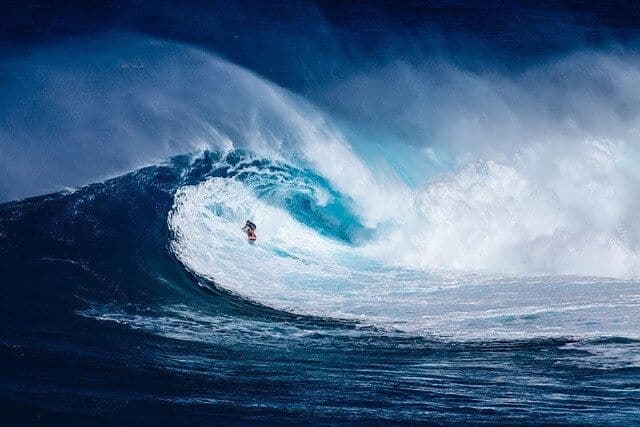I'm going to tell you the story of how I conquered my fear of surfing and define an example strategy for dealing with fears.
Why Was Surfing So Terrifying To Me?
Maybe because during my first surfing experience in Southern Australia, my surfing instructor told us about all the ways I could die or seriously injure myself in the ocean, and just told us to get out there. If you want to know what the things were: it was either shark, jellyfish, rocks, or rip-tide. And yes, I still went out there, feeling really overwhelmed as to what was going on. I could recall her yelling at us to pop up onto our board. Needless to say, all I got out of that experience was the understanding that the ocean is dangerous.
It’s not uncommon for people to have fears. Fears of being in an accident, fear of injuring yourself, fear of dying, whether you’re skiing, surfing, or simply out in city traffic. They are often acquired via having a bad experience with something, or just by having a belief that something is dangerous, the latter of which was my case. For many of my clients, after a car accident, they became unable to get in a car, drive, or sometimes even walk out on the streets as a pedestrian. They feel vulnerable to the unknown, what's going to happen to them, and being injured again. This is where supportive services like Anxiety Counselling and Trauma Therapy can help build resilience and restore confidence.
When we have a fear that we want to conquer, there are two psychological interventions we can use on ourselves or with the help of a therapist to move through it. Working with a therapist such as Angela Leong can provide compassionate guidance as you take gradual steps toward overcoming fear. One method is called "Systematic Desensitization," and the other is called "Exposure Therapy." The former takes a more graduated approach, which involves breaking down the fear into a hierarchy, with opportunities to process with your therapist each baby step you take in stepping towards your fear. This is the method of choice in modern clinical practice. The latter has a much shorter duration of treatment, akin to shock therapy, where you just throw yourself off the deep end and hope that you recognize that it's not as bad as you thought. Our team of psychologists has recognized that because people going into an event with 10/10 fear, their whole mind and body is locked in fear, and can just reinforce more fear of the event. Because of this, Exposure Therapy has recently been re-branded as Exposure Hierarchy.
With Systematic Desensitization, you first identify a small piece of the whole experience that you fear, that you feel that you could manage. For people with car accident phobia, perhaps it's just practicing sitting inside your parked car. For me, I needed to assess the situation, get a sense of the surf shop staff, the ocean, the weather, and the instructor, so I could convince myself that it's safe enough to proceed.
In the therapy room, Systematic Desensitization also involves visualizing the object or event of fear while being guided to practice relaxation strategies such as deep breathing, and using affirming self-statements such as "I am safe", and coming up with rational self-statements such as "Even if anything bad were to happen, I have support, I can heal."
A core aspect of systematic desensitization involves sitting down with a therapist and coming up with a list of scenarios involving the feared object or situation, ordered from least to most frightening.
Step-by-Step Breakdown of How I Conquered My Fear
Here’s the step-by-step breakdown of how I conquered my fear of surfing by breaking down the whole fear of surfing in general into manageable chunks:
Step 1: Calling the Surf Shop and Talking about Potentially Surfing. Anxiety Level = 4/10. I called the front desk and simply inquired about the experience. I had not committed to going out in the waves yet. I just wanted to talk about going out there. I confessed I was terrified, but I wanted to try. I was making her my therapist in this moment, but thankfully, she was so kindly reassuring. She said that Tofino is one of the best places in the world to learn how to surf. I asked her about the weather, the size of the waves. For me, more information gave me an illusion of control. And it helped tremendously.
Step 2: Exposure To the Water. Anxiety Level = 8/10. I was even afraid of how the water was going to be. How cold it was going to be, how violent it was going to be, etc. Just watching the waves rise and fall was terrifying. I did not have a wetsuit or dry suit, but I decided to go for a cold plunge in the evening and become accustomed to the feeling of the water. I took a dunk in the 8-degree water and jumped right back out and back in front of the fireplace.
Step 3: Going to the Surf Shop and Putting on The Gear. Anxiety Level = 6/10. After getting through steps 1 and 2. I was starting to feel more confident. I convinced myself that I was just going to put on a wetsuit. That was the least I could do. This is the mental trick I played on myself: motivating myself via minimal commitment. It works every time.
Step 4: Meeting the Surf Instructor At the Beach. Anxiety Level = 6/10. I met the surfing instructor. I informed him that I was absolutely terrified. This was to prep him to know how to handle a student like me. With extra encouragement and patience, I hoped. And so it was. He was diligent in explaining things thoroughly, and we did lots of practice on how to stand up on the board on land before getting out in the water. And once in the water, he was mindful of my needs.
Et viola, I was riding the waves! It was not as bad as I thought it would be! And I was rewarded with the feeling of being one with nature. Feeling the strength of pachamama was worth it all!
You can see the order of events didn't exactly follow my anxiety levels. I felt that I had to touch the ocean and feel the strength of the waves before I committed to anything. In this regard, you can consider this fear I had of the ocean to be exposure therapy. In this treatment design for my phobia was a combination of exposure therapy with systematic desensitization.
The other strategy I applied to myself that we hadn't discussed yet was commitment to one small aspect of the process, giving yourself the compassion and permission to back-peddle if needed. The self-talk strategy of telling yourself you can always turn back if needed was soothing to the anxious mind. This applies to any big task that we dread in life: whether it's a work assignment or going to the gym. Telling yourself that you'll just pick up the pen or put on your gym clothes and then decide is a sure-fire way to motivate yourself to finish the task.
As you can see, to conquer your fears, it just takes a step-by-step process of gradual exposure of increasing intensity and a little mental trickery of telling yourself that you only have to commit to one tiny step and that you can always turn back if you need to. This process of gradually stepping into greater discomfort works for anything that you're afraid of! To explore how past experiences shape fears, read our blog on Understanding Trauma: The Impact of Big and Small Traumatic Events. Trust me, as a therapist who has worked with a plethora of clients with phobias, including my own, even if it feels like you're tricking yourself, it works! If you’re ready to face your fears with support, book a session with us today.
List of related services:

